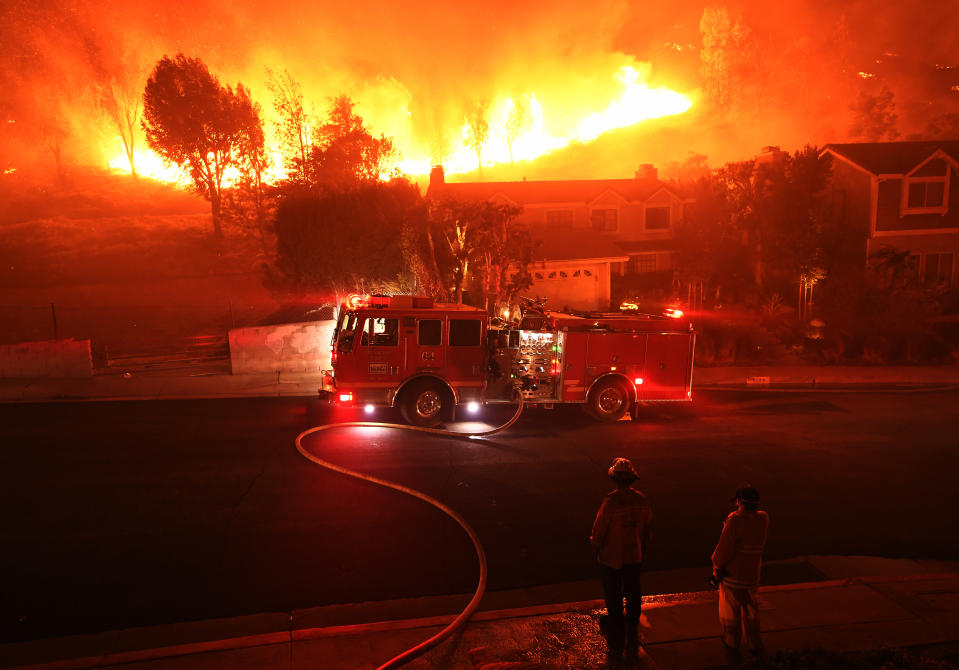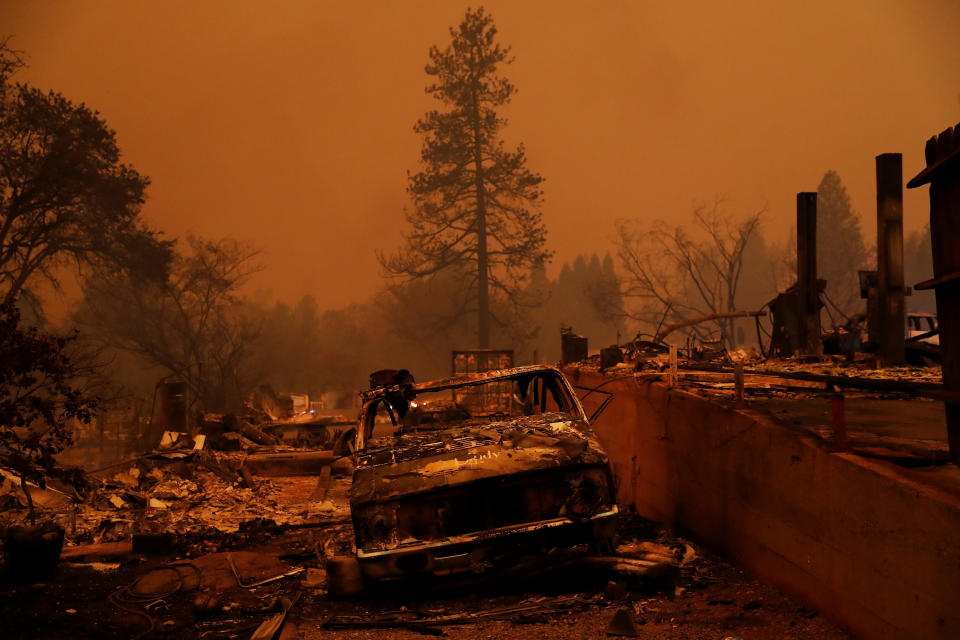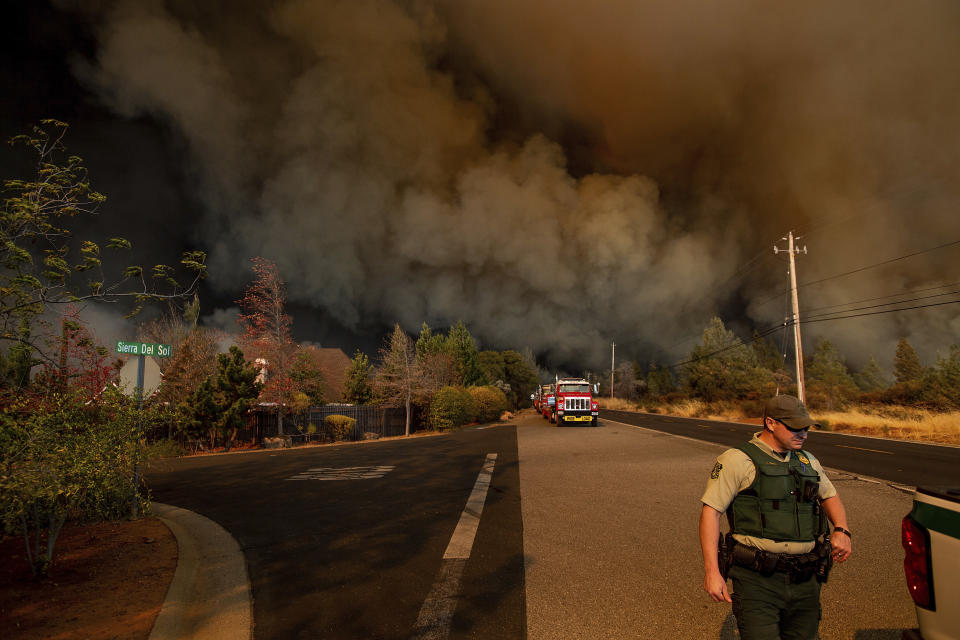Deadliest wildfire in California's history portends what's to come
Exhausted California firefighters are working around the clock to combat the most destructive wildfires in the state’s history — a designation that likely won’t hold for long.
The Camp Fire, which incinerated the town of Paradise in Northern California, has killed at least 48 people and scorched 195 square miles since it began on Thursday, Nov. 8. It is only 35 percent contained. The Woolsey Fire, which destroyed parts of Malibu, killed two people and charred 97,000 acres, is 47 percent contained. The Hill Fire, which charred 4,500 acres in Ventura County, about 60 miles northwest of Los Angeles, is 94 percent contained.
California’s wildfires have steadily become larger, more destructive and more frequent. Experts say the devastating trend will continue as a result of many factors, including forest mismanagement and anthropogenic global warming.
Jonathan Cox, an assistant chief with San Mateo County Fire Department and the California Department of Forestry and Fire Protection (Cal Fire), said this epidemic didn’t sneak up on us in the last few years. Instead, it’s been 100 years in the making: development, population growth and climate change are all factors, and long-term, systemic social change is needed to confront it.
“There are 6,000 firefighters right now that haven’t slept for 36 hours that would do anything for a silver bullet to fix this problem,” Cox told Yahoo News. “For every percent containment you see on these updates, that equates to thousands and thousands of firefighter hours — literally human blood, sweat, tears — to get the percent containment.”

Cox said Cal Fire used to be a seasonal agency but is now staffing more firefighters year-round in response to climate change and an extraordinarily prolonged fire season.
“Our firefighters right now — both in Northern and Southern California — are spending 24-hour shifts doing everything they can to either assist in body recoveries or put in fire line or put in hose lays or get in their dozers and actually cut the hillside,” he said.
Cox said it’s mainly a ground attack with assistance from aircraft where possible — including helicopters and larger tankers — but that Mother Nature’s cooperation is the biggest factor at this point. The flames have been fanned by 60-mph winds, which subsided somewhat on Wednesday, allowing fire crews to make some headway.
“In California right now, we are seeing a shift from a fire season to a way of life. It has the most tragic of consequences,” he said. “It’s stretching everybody from our communities to our firefighters. Our big challenge, I know for my generation, is how we combat this.”
The consequences of climate change are causing and propelling larger and more destructive wildfires than California’s seen in the past. Firefighters have historically taken advantage of cooler temperatures and higher humidity at night, but in recent years they’ve been stymied by round-the-clock high temperatures. California has faced shifting rain patterns and varying degrees of a prolonged drought for the last seven years, and it’s currently going in the wrong direction, leading to drier fields and record-low moisture for trees, the brush, plants and vegetation. Much of California’s forested land has become a veritable tinderbox that only requires an ignition to kickstart these out-of-control fires.

“The scene we’re seeing with these fires — the Santa Rosa fire last year, the Valley Fire the year before, the Paradise Fire this year — is we’re seeing fires grow and expand at rates of spread we’ve never seen before,” Cox said. “We’re looking at fires burning at miles per hour and looking at communities and cities destroyed in a matter of hours.”
Noah Diffenbaugh, an earth science professor at Stanford University and the senior fellow at the Stanford Woods Institute for the Environment, was a lead author for the 2014 report of the United Nations’ Intergovernmental Panel on Climate Change. He said in the last 40 years the area burned in the western United States has increased tenfold and that global warming has accounted for about half of that dramatic rise by drying out the vegetation so it becomes tinder, a phenomenon called fuel aridity.
“This isn’t a matter of opinion. This is a matter of fact. Scientific evidence,” Diffenbaugh told Yahoo News. “What’s clear is that California is in a new climate.”
Though humans are responsible for a majority of the ignitions in California, he said, these dry conditions dramatically increase the wildfire risk.
“In our research, we found that California’s low precipitation years are now twice as likely to co-occur with warm conditions, and we know that that kind of low precipitation and high temperature increases drought risk,” Diffenbaugh said. “It draws moisture out of vegetation and soils, causes more precipitation to fall as rain rather than snow. The snow that does fall melts earlier in the year. These are all trends we are seeing in the historical record and all trends we can expect to see intensify in the future as further global warming occurs.”

Diffenbaugh said California has opportunities to catch up with the climate change that has already happened, become more resilient and prepare for changes to come, but he added that denying the connection between climate change and wildfire risk is extremely dangerous.
“Simply denying that very clearly observed increase in wildfire risk or that global warming is playing a role does nothing to help communities prevent and prepare for these events,” he said.
President Trump downplayed the role of climate change in the current wildfires by blaming “gross mismanagement of the forests” on Twitter. Trump is wrong to dismiss climate change as a major factor, but he’s correct that forest mismanagement is also an important issue.
Niel Lawrence, who used to direct the Natural Resources Defense Council’s forest advocacy initiatives, said there’s sound scientific support for saying that climate change is making wildfires worse and will continue to do so, but Lawrence explained that poor forest management got us into this fix in the first place.
“The background conditions of the forest are the result of a hundred years of mismanagement of public lands, including the cutting of the largest and most fire-resistant trees, which has both left behind the more fire-vulnerable trees and created conditions for a big in-growth of saplings that are really flammable,” Lawrence told Yahoo News.

He said small woody materials, like twigs and needles, are the most flammable things that drive intense fires. But Lawrence also said that by systematically removing the largest trees over the last 100 years, forest managers at the state and national level have created much more flammable forests.
“The physical structure is much more flammable because of management mistakes, and the forest is made drier and more prone to explosive burning by climate change,” Lawrence said.
Tim Brown, the director of the Western Regional Climate Center for the Desert Research Institute in Reno, Nev., said that climate change has enabled more intense wildfires but that fire has always been “very natural” in California.
“A lot of these communities have built up in areas where it’s very easy to have fire. That’s why there’s an expectation that these fires will continue well into the future,” Brown said.
He said there are steps homeowners and communities can take to fireproof houses, but they’re often prohibitively expensive and wouldn’t correct the widespread fuel aridity.

Unlike Trump, California Gov. Jerry Brown understands the climate crisis and has made reducing greenhouse gas emissions and adapting to the changing environment a major issue for his administration. At a press conference on Sunday, he said regular wildfires are not the “new normal” but the “new abnormal.”
“This new abnormal will continue, certainly in the next 10, 15, 20 years. Unfortunately, the best science is telling us that dryness, warmth, drought, all those things, they’re going to intensify,” Brown said.
The vast majority of major scientific associations have published statements affirming that comprehensive scientific evidence clearly shows that global climate change caused by human activities is occurring and poses a significant and growing danger to society. For instance, the American Meteorological Society said in a 2012 statement:
“It is clear from extensive scientific evidence that the dominant cause of the rapid change in climate of the past half century is human-induced increases in the amount of atmospheric greenhouse gases, including carbon dioxide (CO2), chlorofluorocarbons, methane, and nitrous oxide.”
The statewide death toll from the wildfires has reached at least 50, and thousands of homes have been destroyed. Charity Navigator is a helpful resource for finding reliable charities. Groups seeking donations include the California Fire Foundation (which provides short-term financial assistance to victims of fire), the California Community Foundation’s Wildfire Relief Fund (which supports long-term recovery and preparedness efforts) and the American Red Cross (which is providing shelter, food, and comfort for evacuees).
_____
Read more from Yahoo News:
The CIA’s communications suffered a catastrophic compromise. It started in Iran.
Ending the Qatar blockade might be the price Saudi Arabia pays for Khashoggi’s murder
How Robert Mercer’s hedge fund profits from Trump’s hard-line immigration stance
Trump’s target audience for migrant caravan scare tactics: Women
Photos: Heartbreak in Northern and Southern California areas ravaged by wildfires


